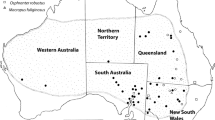Abstract
Eurohippus n.g. is described from the middle to late Eocene (MP 11–16) of Europe as a new genus of equids. Type species isEurohippus parvulus (Laurillard 1849) from Les Prunes near Argenton-sur-Creuse (France). The genus is monotypical. Included are 2 subspecies:Eurohippus parvulus parvulus andEurohippus parvulus messelensis (Haupt 1925).Eurohippus n.g. differs clearly fromPropalaeotherium andLophiotherium with which it was confused before. Phylogenetically,Eurohippus n.g. derived fromPachynolophus of the European early Eocene (MP 10), and not asPropalaeotherium fromPropachynolophus.
Kurzfassung
Eurohippus n.g. wird beschrieben als neue Gattung von Equiden aus dem Mittel- bis Obereozän (MP 11–16) von Europa. Typusart istEurohippus parvulus (Laurillard 1849) von Les Prunes bei Argentonsur-Creuse (Frankreich). Die Gattung ist monotypisch. Eingeschlossen sind 2 Unterarten:Eurohippus parvulus parvulus undEurohippus parvulus messelensis (Haupt 1925).Eurohippus n.g. unterscheidet sich deutlich vonPropalaeotherium undLophiotherium, mit denen die neue Gattung zuvor verwechselt wurde. Stammesgeschichtlich gehtEurohippus n.g. aufPachynolophus aus dem europäischen Untereozän (MP 10) und nicht wiePropalaeotherium aufPropachynolophus zurück.
Similar content being viewed by others
References
Depéret, C. (1901): Révision des formes européennes de la famille des Hyracothéridés. — Bulletin de la Société géologique de France, (4)1: 199–225.
Franzen, J.L. (1988): Messeler Paradepferde und andere Unpaarhufer. — In:Schaal, S. &Ziegler, W. (eds.): Messel — Ein Schaufenster in die Geschichte der Erde und des Lebens: 239–247; Frankfurt a. M. (Verlag Waldemar Kramer).
Franzen, J.L. (1992): The Messel horse show, and other odd-toed ungulates. — In:Schaal, S. &Ziegler, W. (eds.): Messel — An insight into the history of life and of the Earth: 239–247; Oxford (Clarendon Press).
Franzen, J.L. (1994): Neue Säugerfunde aus dem Eozän des Eckfelder Maares bei Manderscheid (Eifel). — Mainzer naturwissenschaftliches Archiv, Beiheft16: 189–211.
Franzen, J.L. (1995): Die Equoidea des europäischen Mitteleozäns. — Hallesches Jahrbuch für Geowissenschaften, Reihe B: Geologie, Paläontologie, Mineralogie,17: 31–45.
Franzen, J.L. (1998a): Das Urpferd von Messel. — In:Koenigswald, W. v. &Storch, G. (eds.): Messel: Ein Pompeji der Paläontologie: 82–83; Sigmaringen (Thorbecke).
Franzen, J.L. (1998b): Urpferde. Ernährung, Verdauung und Evolution. — In:Koenigswald, W. v. &Storch, G. (eds.): Messel: Ein Pompeji der Paläontologie: 84–85; Sigmaringen (Thorbecke).
Franzen, J.L. (1998c): Le cheval archaïque de Messel. — InKoenigswald, W. v. &Storch, G. (eds.): Messel. La mémoire de la Nature: 82–83; Sigmaringen (Thorbecke).
Franzen, J.L. (1998d): Chevaux archaïques. Alimentation, digestion et évolution. — In:Koenigswald, W. v. &Storch, G. (eds.): Messel. La Mémoire de la Nature: 84–85; Sigmaringen (Thorbecke).
Franzen, J.L. &Haubold, H. (1985): The European Middle Eocene of Mammalian Stratigraphy. — Terra cognita,5: 134.
Franzen, J.L. &Haubold, H. (1986a): Revision der Equoidea aus den eozänen Braunkohlen des Geiseltales bei Halle (DDR). — Palaeovertebrata,16 (1): 1–34.
Franzen, J.L. &Haubold, H. (1986b): The Middle Eocene of European Mammalian Stratigraphy. Definition of the Geiseltalian. — Modern Geology,10: 159–170.
Haupt, O. (1925): Die Palaeohippiden der eozänen Süßwasserablagerungen von Messel bei Darmstadt. — Abhandlungen der Hessischen Geologischen Landesanstalt,6 (4): 1–159.
Hooker, J.J. (1986): Mammals from the Bartonian (middle/late Eocene) of the Hampshire Basin, southern England. — Bulletin of the British Museum (Natural History), Geology series,39 (4): 191–478.
Hooker, J.J. &Weidmann, M. (2000): The Eocene mammal faunas of Mormont, Switzerland. Systematic revision and resolution of dating problems. — Schweizerische Paläontologische Abhandlungen,120: 1–143.
Koenigswald, W. v. (1998a): Stute vom Urpferd. — In:Koenigswald, W. v. &Storch, G. (1998, eds.): Messel. Ein Pompeji der Paläontologie: 86–87; Sigmaringen (Thorbecke).
Koenigswald, W. v. (1998b): La jument du cheval archaïque. — In:Koenigswald, W. v. &Storch, G. (1998, eds.): Messel. La Mémoire de la Nature: 86–87; Sigmaringen (Thorbecke).
Laurillard, C.L. (1849): Lophiodon. — InD’Orbigny, A.: Dictionnaire Universel d’Histoire Naturelle,7: 438–439; Paris.
Mertz, D.F., Harms, F.-J., Gabriel, G. &Felder, M. (2004): Arbeitstreffen in der Forschungsstation Grube Messel mit neuen Ergebnissen aus der Messel-Forschung. — Natur und Museum,134 (9): 289–290.
Mertz, D.F. &Renne, P.R. (2005): A numerical age fort the Messel fossil deposit (UNESCO World Heritage Site) derived from40Ar/39Ar dating on a basaltic rock fragment. — In:Harms, F.-J. &Schaal, S. (Eds): Current Geological and Paleontological Research in the Messel Formation; Courier Forschungsinstitut Senckenberg,255: 67–75.
Rütimeyer, L. (1891): Die eocäne Säugethier-Welt von Egerkingen. Gesammtdarstellung und dritter Nachtrag zu den „Eocänen Säugethieren aus dem Gebiet des Schweizerischen Jura (1862).“ — Abhandlungen der schweizerischen paläontologischen Gesellschaft,18: 1–153.
Russell, D.E.,Hartenberger, J.-L.,Pomerol, C.,Sen, S.,Schmidt-Kittler, N. &Vianey-Liaud, M. (1982): Mammals and Stratigraphy: The Paleogene of Europe. — Palaeovertebrata Montpellier, Mémoir Extraordinaire: 1–77.
Savage, D.E., Russell, D.E. &Louis, P. (1965): European Eocene Equidae (Perissodactyla). — University of California Publications in Geological Sciences,56: 1–94.
Stehlin, H.G. (1904): Die Säugetiere des schweizerischen Eocaens. Critischer Catalog der Materialien. Zweiter Teil:Palaeotherium. — Plagiolopus. — Propalaeotherium. — Abhandlungen der schweizerischen paläontologischen Gesellschaft,31: 155–445.
Sudre, J. (1978): Les artiodactyles de l’Eocène moyen et supérieur d’Europe occidentale (systématique et évolution). — Mémoirs et travaux de l’Ècole pratique des hautes Études,7: 1–229.
Thaler, L. (1966): Les Rongeurs Fossiles du Bas-Languedoc dans leurs Rapports avec l’Histoire des Faunes et la Stratigraphie du Tertiaire d’Europe. — Mémoirs du Muséum National d’Histoire Naturelle Paris, (C)17: 1–295.
Tobien, H. (1968): Mammifères éocènes du Bassin de Mayence et de la partie orientale du Fossé rhénan. — Mémoirs du Bureau des Recherches de Géologie et Minéralogie,58: 297–307.
Author information
Authors and Affiliations
Corresponding author
Rights and permissions
About this article
Cite this article
Franzen, J.L. Eurohippus n.g., a new genus of horses from the Middle to Late Eocene of Europe. Senckenbergiana lethaea 86, 97–102 (2006). https://doi.org/10.1007/BF03043638
Received:
Accepted:
Issue Date:
DOI: https://doi.org/10.1007/BF03043638



